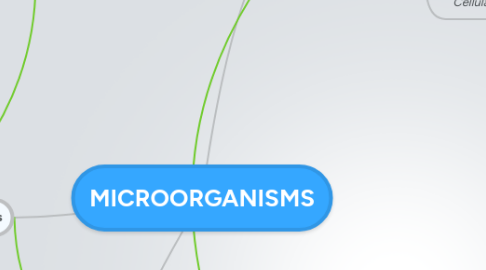
1. Cell structure
1.1. Cell wall
1.2. Internal
1.2.1. Cytoplasm
1.2.2. Nucleus
1.2.3. Organelles (lysosomes)
1.2.4. Mitochondria
1.2.5. Cytoskeleton
1.2.6. Endospore
1.3. External
1.3.1. Flagella
1.3.2. Cilia
1.3.3. Glycocalyx (surface coat)
2. Prokaryotes
2.1. Archaea
2.1.1. Survive extreme temperatures (i.e. volcanoes, Arctic)
2.2. Bacterium
2.2.1. Cell wall
2.2.1.1. Gram-Negative (-)
2.2.1.1.1. Thin Peptidoglycan wall
2.2.1.2. Gram-Positive (+)
2.2.1.2.1. Thick Peptidogylcan wall
2.2.2. Spore-Producing
2.2.3. Nucleoid (condensed DNA containing bacterial chromosomes)
2.2.4. Pilus
2.2.4.1. Allows exchange of DNA
2.2.5. Reproduces with Binary Fission
2.2.6. Requires organic source of carbon
2.2.7. Mesophile (20-40 degrees Celcius)
3. Nomenclature
3.1. SAME
3.2. Except Viruses
4. RNA nucleic acid
4.1. Single-stranded
4.1.1. (+) positive polarity (i.e. Poliovirus)
4.1.2. (-) negative polarity (i.e. Influenza virus)
4.1.3. reverse transcriptase (i.e. HIV/AIDS)
4.2. Double-stranded
4.2.1. i.e. Rotavirus (gastroenteritis)
5. DNA nucleic acid
5.1. Double-stranded (i.e. Herpes Simplex II virus)
5.2. Single-stranded (i.e. Parvovirus)
6. Eukaryotes
6.1. Non-cellular (non-living)
6.1.1. Virus
6.1.1.1. Viroid (parasite virus-like pathogen that affects plants)
6.1.1.2. Satellite virus (virus that affects another virus)
6.1.1.3. Reproduces with replication
6.1.2. Prion
6.1.2.1. Made of proteins, no nucleic acid
6.2. Cellular (Living)
6.2.1. Unicellular
6.2.1.1. Protozoan
6.2.1.1.1. Trophozoite stage (living stage)
6.2.1.1.2. Cyst stage (dormant stage)
6.2.1.1.3. Heterotrophic (uses complex organic food)
6.2.1.1.4. Requires moisture
6.2.1.1.5. Does not colonize
6.2.1.1.6. No cell wall
6.2.1.2. Fungus
6.2.1.2.1. Macroscopic
6.2.1.2.2. Microscopic
6.2.1.2.3. Grows well in moisture
6.2.1.2.4. Heterotrophic (complex organic food requirement
6.2.1.2.5. Obligate(dies in contact with O2) or facultative anaerobe (does not require but can live in contact with O2)
6.2.2. Multicellular
6.2.2.1. Helminth
6.2.2.1.1. Platyhelminthe (flat worm)
6.2.2.1.2. Aschelminthe (round worm)
6.2.2.1.3. Three (3) life stages
